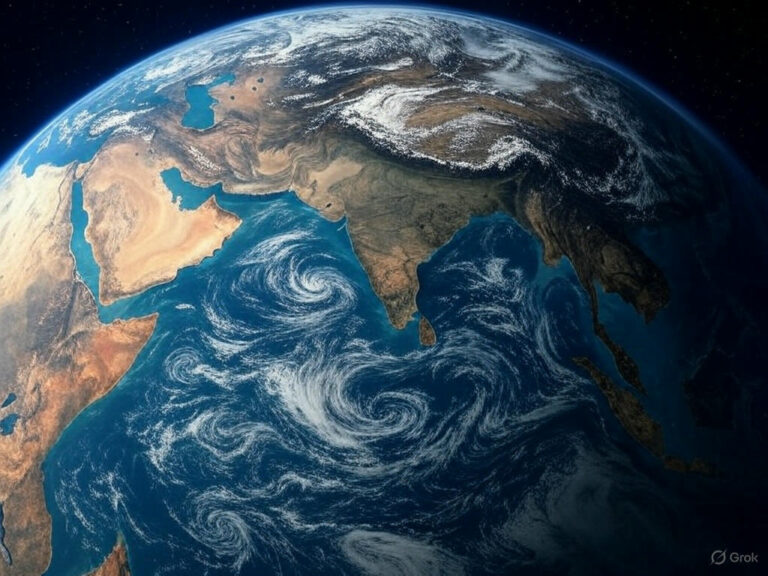William Whewell’s Progressive Theory of Ocean Tides
Suppose you are standing on a beach, watching the waves roll in. Some waves crash directly, while others bounce off obstacles before reaching the shore. Now, scale this up to an oceanic level—that’s how tides behave, according to William Whewell’s Progressive Wave Theory (1883).
Unlike Newton’s Equilibrium Theory, which assumes an ideal, water-covered Earth, Whewell recognized that the real Earth is heterogeneous, with continents, varying ocean depths, and irregular coastlines affecting tidal motion.
The Core Principles of the Progressive Theory
Whewell’s theory builds on several observations:
- Tides occur at different times at different places along the same longitude, proving they don’t act simultaneously across the globe.
- Tides behave like waves, moving across the ocean’s surface from East to West due to the Moon’s gravitational force.
- The crest of these waves represents high tide, while the trough represents low tide (ebb tide).
- The depth of the ocean affects the speed and length of these tidal waves—deeper oceans allow faster wave movement.
How Tidal Waves Propagate
- If Earth were a perfect water-covered sphere, tidal waves would move smoothly from East to West without obstruction.
- However, continents act as barriers, disrupting this free flow.
- Since continents are oriented North-South, they interfere with tidal waves, deflecting and reflecting them.
- The least obstructed tidal movement occurs in the Southern Ocean around Antarctica, where vast stretches of open water allow uninterrupted wave propagation.
Primary, Secondary, and Minor Tidal Waves
The Progressive Theory explains tides as a cascade of waves:
- Primary Waves (Forced Waves)
- These originate in the Southern Ocean due to the Moon’s gravitational pull.
- They move East to West without much resistance.
- When these waves hit continental barriers, they get deflected northward, creating Secondary Waves.
- Secondary Waves (Derived Waves)
- As primary waves hit landmasses, they split and move northward, still maintaining an East to West direction.
- These are less influenced by the Moon and behave more independently.
- Smaller Minor Waves are further generated from these secondary waves.
- Minor Waves
- These move progressively northward, losing energy and magnitude but still generating tides in various regions.
- The time delay in tides along the same longitude occurs because these waves take time to travel.
Evaluating the Theory – Strengths & Limitations
✅ Supporting Evidence:
- Tidal records show that spring tides occur nearly simultaneously from Cape Horn (South America) to Greenland (North Atlantic), supporting the idea of tides moving progressively northward.
❌ Limitations:
- Tides are largely local or regional phenomena—many tides result from specific coastal shapes, ocean basins, and local wind conditions, not just from Southern Ocean waves.
- While the Progressive Theory explains global tidal movement, it does not account for complex oceanic interactions, which later theories, such as the Dynamic Theory of Tides, have improved upon.
Conclusion
The Progressive Wave Theory was a crucial advancement in understanding tides. By recognizing the role of landmasses, ocean depth, and wave movement, it provided a more realistic framework than Newton’s Equilibrium Theory.
However, tides are far more complex than a simple wave moving northward from Antarctica. Today, modern oceanography integrates both Newtonian principles and Whewell’s dynamic wave movement, further refining our understanding of this fascinating natural phenomenon!
UPSC Sample Question:
Q. Explain why ocean tides appear to move from East to West across the Earth’s surface. Discuss the role of the Earth’s rotation and the gravitational influence of the Moon in shaping tidal movements.
Answer:
Introduction:
Tides are periodic rises and falls of ocean water caused primarily by the gravitational pull of the Moon and, to a lesser extent, the Sun. While the Moon’s gravitational force acts uniformly, tides appear to move from east to west due to the combined effects of the Earth’s rotation and the Moon’s relative motion.
Role of the Moon’s Gravitational Pull:
- The Moon exerts a gravitational force on the Earth’s oceans, creating two tidal bulges: one directly beneath the Moon and the other on the opposite side due to centrifugal force.
- These bulges remain aligned with the Moon as the Earth rotates, causing successive high and low tides.
Effect of Earth’s Rotation:
- The Earth rotates from west to east (counterclockwise when viewed from above the North Pole).
- Since tidal bulges remain aligned with the Moon, an observer on Earth perceives tides moving from east to west relative to the surface.
- This apparent westward movement is a result of Earth’s rotation beneath the stationary tidal bulges.
Role of the Moon’s Motion:
- The Moon orbits the Earth in the same direction as Earth’s rotation (west to east), but at a slower rate.
- As a result, each tidal cycle occurs approximately 12 hours and 25 minutes apart, slightly shifting the tide timings daily.
Conclusion:
The westward movement of tides is an apparent motion caused by the Earth’s eastward rotation under the influence of the Moon’s gravitational pull. Understanding this phenomenon is crucial for navigation, coastal management, and disaster preparedness.






